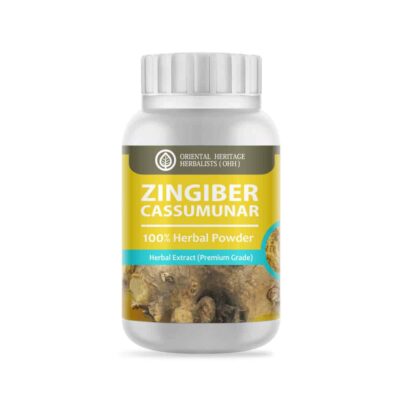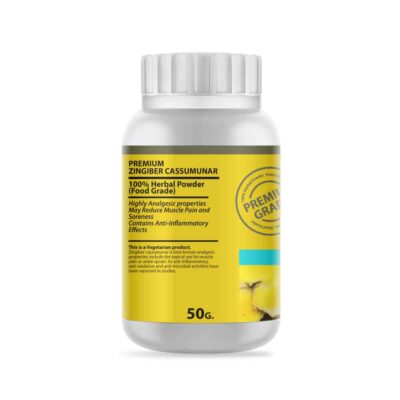The Evolving Status of Zingiber cassumunar
Zingiber cassumunar Roxb. (Family: Zingiberaceae), commonly known in Thailand as “Plai,”. It is a perennial herbaceous plant with a long-standing history in traditional Southeast Asian medicine. Historically, its rhizome extracts have been utilized topically to address musculoskeletal pain, sprains, and inflammatory skin conditions. Contemporary scientific investigations have moved beyond ethnobotanical claims, focusing on the sophisticated phytochemistry of Plai to validate its application in modern health and beauty industries.
The primary bioactivity of Zingiber cassumunar is attributed to its rich composition of secondary metabolites, notably:
- Phenylbutenoids: Including (E)-1-(3,4-dimethoxyphenyl)butadiene (DMPBD) and (E)-4-(3,4-dimethoxyphenyl)but-3-en-1-ol (Compound D).
- Essential Oils: Characterized by high concentrations of sabinene and terpinen-4-ol.
- Curcuminoids: Compounds structurally related to those found in turmeric.
This review synthesizes current research detailing the established and emerging benefits of Z. cassumunar for cosmeceutical development and nutritional supplementation.
I. Cosmeceutical Applications: Topical Analgesia and Anti-Aging
The skin is perpetually exposed to environmental stressors that induce oxidative damage and chronic, low-grade inflammation, leading to premature photoaging. Z. cassumunar extracts offer a multi-target mechanism for mitigating these effects.
A. Potent Anti-Inflammatory and Analgesic Efficacy
The most well-documented topical benefit of Plai is its anti-inflammatory activity. Clinical and preclinical studies confirm that the phenylbutenoids, particularly Compound D, exert effects comparable to non-steroidal anti-inflammatory drugs (NSAIDs) by modulating key inflammatory pathways.
- Mechanism of Action: Studies suggest the active compounds inhibit the production of pro-inflammatory mediators. For example; prostaglandin $\text{E}_2$ ($\text{PGE}_2$) and nitric oxide (NO), in challenged cellular models.
- Clinical Relevance: Topical formulations (e.g., creams, balms) containing Z. cassumunar essential oil have been clinically shown to reduce pain and inflammation. It’s associated with musculoskeletal disorders, including delayed onset muscle soreness (DOMS) and ankle sprains. Furthermore, its efficacy in reducing pain scores in conditions like painful diabetic neuropathy is underscored. It has potential as a localized analgesic agent.
B. Photoaging Protection and Dermal Remodeling
Z. cassumunar extracts demonstrate significant potential in the anti-aging sector through antioxidant activity and modulation of dermal matrix components.
- Antioxidant Capacity: The essential oil and curcuminoid content exhibit potent radical scavenging activity against free radicals, such as 2,2′-azinobis-(3-ethylbenzothiazoline-6-sulfonic acid ($\text{ABTS}^{+}$) and 1,1-diphenyl-2-picrylhydrazyl ($\text{DPPH}$). This capacity is crucial for protecting dermal cells from oxidative stress-induced damage.
- Collagen Synthesis and Protection: Research indicates that certain extracts can promote the secretion of collagen by human dermal fibroblasts ($\text{HDF}$ cells), which is vital for maintaining skin firmness and elasticity. Additionally, the inhibition of elastase activity suggests a protective role against the breakdown of the extracellular matrix, a hallmark of photoaging.
- Antimicrobial Properties: The essential oil also exhibits antimicrobial activity against various bacteria and fungi, making it a viable candidate for anti-acne and antiseptic topical applications.
II. Nutritional Supplementation: Systemic Health Benefits
As a dietary supplement, Zingiber cassumunar is positioned to support systemic health by leveraging its core anti-inflammatory and neuroprotective properties.
A. Systemic Anti-Inflammation and Pain Management
While topical use is common, the oral consumption of standardized extracts is investigated for systemic inflammatory conditions. The bioactivity observed topically suggests a potential role for oral administration in mitigating chronic inflammation associated with various degenerative diseases.
B. Emerging Neuroprotective Potential
Recent preclinical studies have highlighted a fascinating benefit in the realm of neuroprotection.
- Mechanism: Oral administration of Z. cassumunar extract has demonstrated an ability to attenuate neuronal cell loss and suppress the activation of astrocytes in models of lipopolysaccharide (LPS)-induced neuroinflammation.
- Significance: This suggests that the bioactive components of Plai may cross the blood-brain barrier to exert anti-inflammatory effects within the central nervous system, offering a novel avenue for research into neurodegenerative disease management.
III. Safety and Standardization
In line with the academic tone, the safety profile is a critical consideration. Acute and chronic oral toxicity studies in animal models have generally demonstrated a favorable safety profile, with high dosage showing no adverse mortality. However, the efficacy of an extract is highly dependent on standardization. Future research must focus on standardizing extracts based on the concentration of key phenylbutenoids (e.g., DMPBD and Compound D) to ensure reproducible therapeutic outcomes in both cosmeceutical and supplement products.
Conclusion
Zingiber cassumunar is transitioning from a traditional remedy to a scientifically substantiated natural ingredient. Its dual utility, driven by potent anti-inflammatory, antioxidant, and analgesic properties, makes it a valuable botanical for advanced cosmeceutical formulations targeting photoaging and pain relief, and for nutritional supplements aimed at systemic anti-inflammation and neuroprotection. Continued research, particularly clinical trials focusing on oral administration and standardized marker compounds, will further solidify its position in global health and wellness markets.
Explore the website to learn more: Click Here
Related Products
Related Post
Citrus Hystrix (Kaffir Lime): Powerful Benefits for Food, Cosmetic, and
The Evolving Status of Zingiber cassumunar Zingiber cassumunar Roxb. (Family: Zingiberaceae), commonly.
- 14 November 2025
- 0 Comments
Hibiscus Sabdariffa: The Beauty and Wellness Benefits of the Roselle
The Evolving Status of Zingiber cassumunar Zingiber cassumunar Roxb. (Family: Zingiberaceae), commonly.
- 13 November 2025
- 0 Comments
Plumbago Indica: The Gem in Herbal Skincare and Wellness Supplements
The Evolving Status of Zingiber cassumunar Zingiber cassumunar Roxb. (Family: Zingiberaceae), commonly.
- 12 November 2025
- 0 Comments
Elephantopus Scaber: A Powerful Herbal Extract for Skin Health and
The Evolving Status of Zingiber cassumunar Zingiber cassumunar Roxb. (Family: Zingiberaceae), commonly.
- 10 November 2025
- 0 Comments
Alpinia Galanga: The Herbal Powerhouse Transforming Cosmetics and Supplements
The Evolving Status of Zingiber cassumunar Zingiber cassumunar Roxb. (Family: Zingiberaceae), commonly.
- 7 November 2025
- 0 Comments









